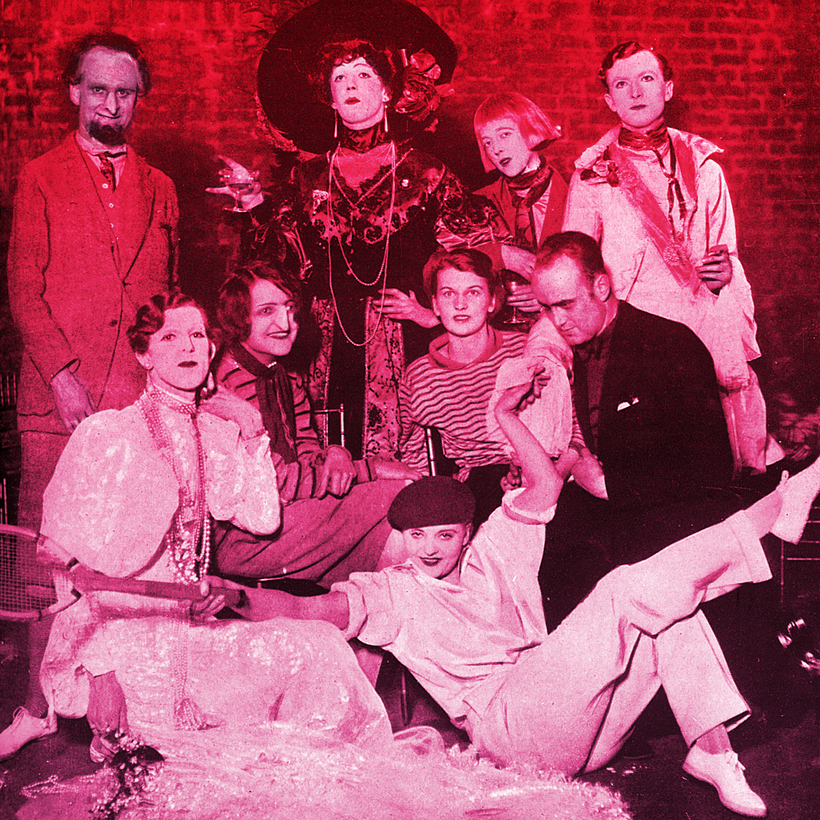For the male contingent of the Bright Young Things who bestrode the 1920s, carrying powder compacts and lipsticks came with a heavy penalty. If found wandering around central London with said accoutrements, they were liable to be charged with importuning persons for immoral purposes and sentenced to three months in prison. But these “painted boys,” as they came to be known in the English tabloids, were not easily cowed.
Many of them had already been persecuted during World War I for their avowed pacifism and were hardened by the experience. John Rothenstein, who directed the Tate Gallery, in London, for nearly 30 years, saw their imprint of effeminacy as “the defiant assertion of the dandified intellectual (or ‘aesthete’ as he was called) in the face of the formerly hectoring athlete, or ‘hearty.’”
Nino Strachey, a descendant of Lytton Strachey—the author of Eminent Victorians (1918) and one of the leading lights of the Bloomsbury set—finds much to admire about these aesthetes in Young Bloomsbury: The Generation That Redefined Love, Freedom, and Self-Expression in 1920s England. The moniker “Young Bloomsbury” can be explained by the way this younger generation gravitated toward the nurturing example of their elders in the Bloomsbury set.

They looked up to Bloomsbury writers such as Lytton Strachey, Virginia Woolf, and E. M. Forster, the economist John Maynard Keynes, and artists like Duncan Grant and Dora Carrington for their unapologetic queerness and iconoclastic modernism. Chief among them were the artist Stephen Tennant, ever after known as the “brightest” of the Bright Young Things, the writers Eddy Sackville-West and Julia Strachey (niece of Lytton’s), the sculptor Stephen Tomlin, the photographer Cecil Beaton, and the journalist Raymond Mortimer.
It was Mortimer who provided Woolf and Grant with a highly visible platform in Vogue for their respective writings and illustrations. This sort of cross-pollination worked both ways, with Woolf championing Julia Strachey’s first novel, Cheerful Weather for the Wedding (1932), and Woolf, Grant, and Lytton Strachey all posing for Tomlin, who created iconic busts of these three leading Bloomsberries.
Nino Strachey is the last member of the Strachey family to have grown up at Sutton Court in Somerset, home of the family since the 1850s. In her book, she explains that as the mother of “a child who identifies as gender-fluid and queer” she has seen how “older people play a vital role when they show their support, building confidence, nurturing future talent.” The template that was established by the Bloomsbury set, whereby they created “a family of choice,” as opposed to one of blood relations, now seems positively revolutionary.
A month before Lytton Strachey died, in 1932, at the age of 51, he wrote: “In this wretched world unkindness is out of place.” It is an uncommon mantra that finds many different forms in Nino Strachey’s book. The fact that both Eddy Sackville-West and Stephen Tennant lived to a ripe old age was due to the support they received not from their families but from their friends. Homosexuality was still considered a degenerate illness in the 1920s—Sackville-West was subjected to an eight-week “cure” in Germany involving painful testicular injections, while Tennant spent a year of “virtual isolation” in a psychiatric hospital.
.Nino Strachey describes London in the 20s as “a place of confusing extremes. On one side stood this new, syncopated world of the Bright Young Things—treasure hunts, fancy-dress parties, jazz music, and cocktails. On the other stood the old establishment, stern figures of Conservative reaction, represented most fearsomely by William Joynson-Hicks, repressive home secretary from 1924 to 1929, who cracked down on nightclubs and indecent literature.”

Strachey’s book details the first side of this standoff in compelling depth, but how much more complete it would have been if she had looked more closely at Establishment figures like Joynson-Hicks and what drove their animus. The Bloomsbury set is also given a very easy ride. There is the smallest hint of predatory behavior when Strachey writes that Keynes used his position as an economics lecturer at King’s College, Cambridge, “to befriend and seduce graduates.” But that is as far as she is prepared to go, though Keynes himself kept a record of his teenage conquests and professed himself an “immoralist.”
On the subject of the artistic achievements of Young Bloomsbury, Strachey writes that their “output was often destined to be damned by faint praise, their efforts viewed through an unreliably hostile lens.” Nonetheless, it is preternaturally difficult to make a wholly convincing case for their creative work when it was busy being overshadowed by the Zeitgeist-changing contributions of their elders, such as Woolf, Forster, and Lytton Strachey. Indeed, Stephen Tennant’s most lasting impact seems to have been as a muse, inspiring characters in stellar novels such as Nancy Mitford’s Love in a Cold Climate (1949) and Evelyn Waugh’s Vile Bodies (1930) and Brideshead Revisited (1945).
It is no small achievement in itself, and Strachey’s book, written through a 21st-century prism, makes Tennant and his acolytes appear more marvelously modern than they ever were.

Tobias Grey is a Gloucestershire, U.K.–based writer and critic, focused on art, film, and books


